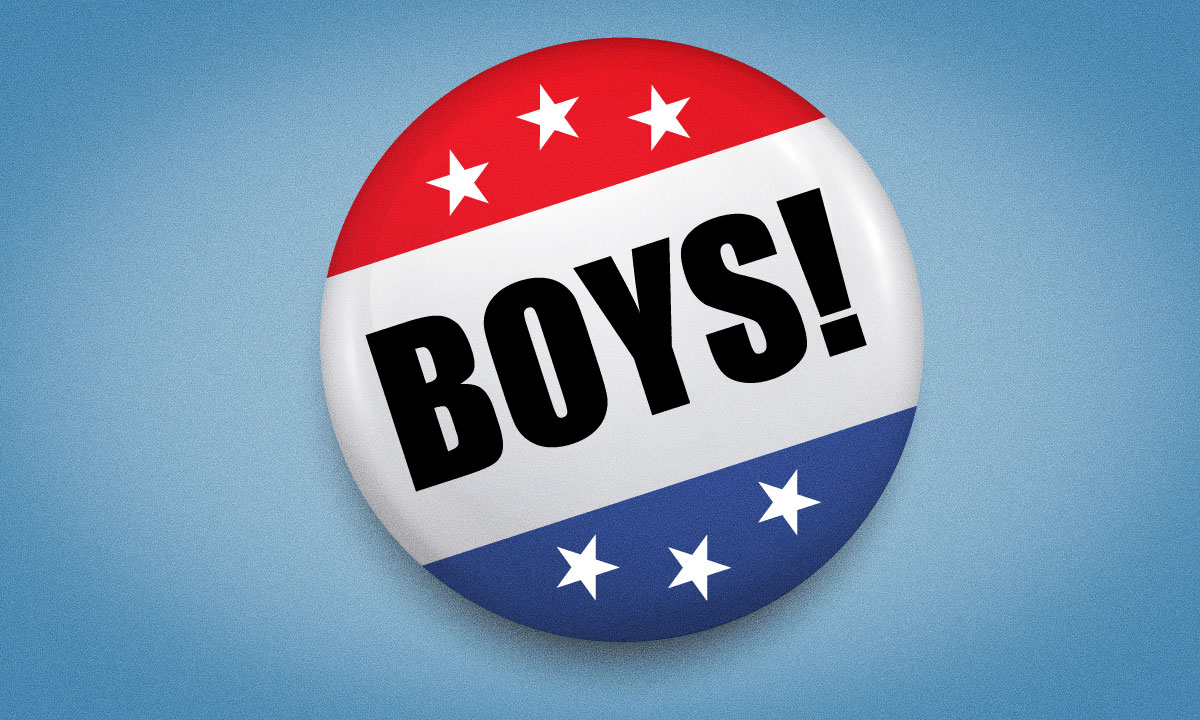Tackling Boys’ Struggles in School and Life Could Hold Key to Political Success
Author Richard Whitmire says the issue — now garnering lots of media attention — is a potential electoral boon for the party that seizes it first.

Get stories like this delivered straight to your inbox. Sign up for The 74 Newsletter
Just laying there untouched is the plumpest political opportunity you could possibly imagine: the “boys” issue. Why have boys fallen behind, in both school and life, and how do we fix the problem?
This juicy prize is up for grabs, for both Dems and the GOP, but they better move fast. Think of playing Monopoly and landing on Reading Railroad, failing to buy it — and regretting it for the rest of the game.
How big is the prize? Imagine the politically decisive universe of soccer moms, half of whom have boys, who have been fretting for years over why the girls in their classes, and even their own daughters, do SO much better in school than their sons.
And why so many of their sons, in later years, qualify as “failures to launch.” The clearest signal of that problem: the rising number of stories about young men (far less so with women) still living at home, often feeling aimless, stuck and socially isolated.
Could the “boys” vote matter? Oh yeah, at least where I sit as a Virginia resident. Glenn Younkin got elected as governor in 2021 here by stirring up parents in places such as prosperous Loudoun County over discipline, masking and transgender students’ bathroom and locker room use. That’s small potatoes compared to the broader boy problems.
The reason this issue has such political potential is there’s a relatively simple explanation for the male school dilemma. And, there’s a fix for the problem that’s somewhat difficult, but definitely doable.
A bit of background. Thanks to the 1989 education summit in Charlottesville, Virginia that drew 49 governors and then-President George H. W. Bush, a decision was made to push academic rigor earlier, by about two grades, as I document in my 2011 book, Why Boys Fail. Bottom line: First graders soon got handed the work that third graders had been doing.
The governors’ intentions were spot on. The U.S. was slipping behind other countries in academic comparisons. Something had to be done to boost college readiness. This reform should do it, right?
The result, however, was something no one expected. Boys, whose brains aren’t wired for early literacy rigor, fell behind. In short, those same boys looked at the girls, exulting in their comparative literacy excellence, and said, “No thanks. We find video games far more attractive.”
Teachers, who should have known better, in many cases just shrugged their shoulders. Aren’t there meds available for hyperactive boys who can’t adjust to these new standards?
The result, by the numbers, is bracing. I suggest a look at the data documented by the American Institute for Boys and Men.
Some quick examples: At age 5, there is a 14 percentage point gender gap in school readiness favoring girls, who are poised to soak up those early academic challenges. Where does that lead? Two-thirds of those in the top decile of high school GPAs are girls; two- thirds of those in the bottom are boys. There is a 15 percentage point gender gap favoring women in students earning bachelor’s degrees.
There are multiple small fixes schools can undertake to correct the boys’ problems. Educators already know what to do: Roughly the same things they did for girls years ago to successfully correct for math and science academic deficiencies. By making math and science into participatory projects, bringing female scientists into their classrooms as role models and focusing on encouraging more girls to take an interest in those subjects, they turned it around. Before being reopened with the pandemic, the disparity between boys’ and girls’ middle school math and science scores had disappeared.
But I digress.
Again, the question is: Who’s going to get there first and claim the political rewards? My current betting is on Donald Trump, who polls well among young men. A lot of struggling guys find a kindred spirit in the chip-on-the shoulder president.
For Trump, this is a perfect fit: Confront the mostly female teachers unions, who have historically insisted the “boy problems” are exaggerated. How bad can it be when men dominate Congress and top business jobs? Then claim that “woke” school administrators prefer to focus on girls and minorities. He could demand changes such as an intense focus on boys in elementary school literacy instruction. The exact changes may be less important than the mandate to pay attention, which is what happened with girls and science.
What’s to lose? They aren’t his supporters. This is such an easy ”get” that I’m surprised that Trump’s staffers haven’t thought of it.
My sentimental bet, however, is on the Democrats, who could potentially use it to help win back the lead they long held — and then lost — as being seen among voters as the more trusted party on education. It’s the ideal issue for moving the party away from the woke wing. I’m thinking former Chicago mayor Rahm Emanuel, currently floating himself as a 2028 presidential contender, could run with this, along with centrist Democrats, such as Sen. Elissa Slotkin of Michigan, who recently described herself as being on “team normal.”
On the surface, this would appear to be a no-go issue for the Democrats. The teachers unions remain among their most valuable allies. Unless, that is, a candidate such as Emanuel gains momentum. Remember his clashes with the Chicago Teachers Union? They called him a bully, a liar and an “imperial mayor.” Exactly the credentials needed to take this on and win the soccer mom votes in affluent suburbs.
The midterm elections aren’t far away, so the race is on. Which party will seize the ripe, vote-rich boys issue?
Get stories like these delivered straight to your inbox. Sign up for The 74 Newsletter

;)
